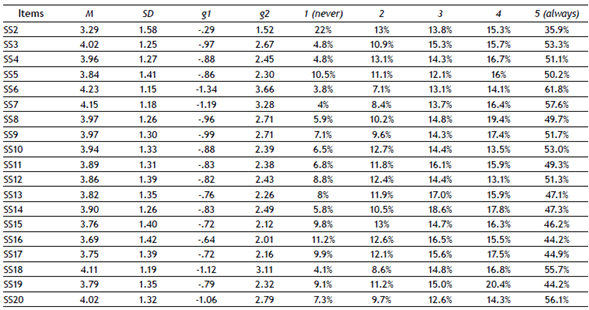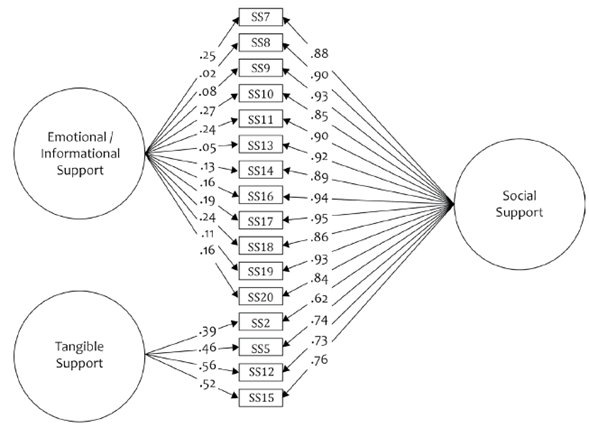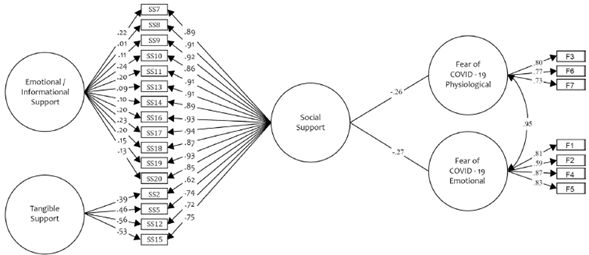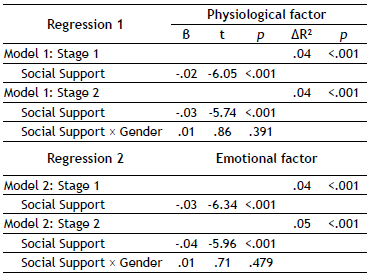On March 11, 2020, the World Health Organization declared the SARS-CoV-2 virus disease pandemic (COVID-19). From that moment on, a series of measures were implemented to curb the spread of the contagion (social distancing and confinement), which had an impact on people’s daily lives, significantly affecting the mental health and psychosocial well-being of the worldwide population (Gallegos et al., 2020).
In Mexico, several studies have reported higher levels of stress, anxiety and depression (Toledo-Fernández et al., 2021), as well as diverse psychological symptomatology at the behavioral and family levels (Torres et al., 2020) during the COVID-19 pandemic. In this regard, a topic of particular current interest has been the role of social support as a psychosocial protective factor against mental health difficulties during the pandemic (Grey et al., 2020). Social support can be interpreted in two ways: perceived social support and received social support. Perceived social support is the subjective assessment of how individuals perceive the availability of material, psychological, and general support from friends and family members in times of need; whereas received support refers to the actual amount of support the individual has received (Eagle et al., 2019). The literature reports a strong relationship between low levels of perceived social support and poor mental health (Lakey & Cronin, 2008).
During the pandemic, Grey et al. (2020) found that individuals with high levels of perceived social support had a 63% and 52% lower risk of experiencing elevated levels of depressive symptoms and poor sleep quality, respectively. Other studies indicated that high levels of perceived social support are associated with lower levels of post-traumatic stress (Liu et al., 2020), anxiety symptoms (Qi et al., 2020), and fear of COVID-19 (Muyor-Rodríguez et al., 2021), thus mitigating the effects of social isolation. Based on these findings, we hypothesized that higher levels of social support would help the mental health of the general population in Mexico during the COVID-19 pandemic.
In order to measure perceived social support, several instruments have been developed (Dambi et al., 2018). One of these instruments is the Medical Outcomes Study Social Support Survey (MOS-SSS), initially developed by Sherbourne and Stewart (1991) for use in patients with chronic diseases. Originally, the MOS-SSS consisted of 19 items distributed in five dimensions referring to different aspects of social support: affect, positive social interaction, emotional support, informational, and tangible or material. Subsequently, Sherbourne and Stewart (1991) proposed that the emotional and informational support dimensions be combined into a single one called emotional/informational support, leaving the MOS-SSS with four dimensions. However, in Spanish the MOS-SSS has presented structures of three dimensions in a general sample from Colombia (Londoño et al., 2012) and with Spanish outpatients (Costa et al., 2007); as well as structures of two dimensions (conformed by 16 items) in HIV+ outpatients from Mexico (Martínez et al., 2014) to cite a few studies. Except for the psychometric study by Londoño et al. (2012), most studies have analyzed the scale in populations with some type of disease. In Mexico, it was validated among HIV+ patients (Martínez et al., 2014); it has also been used in patients with mental (Casanova-Rodas et al., 2014) and cardiovascular diseases (Herrera et al., 2021). However, no psychometric evaluation of the MOS-SSS in the general population during the pandemic has been reported so far. Therefore, it is important to have an instrument validated in the general population in the context of the COVID-19 pandemic. In the current pandemic, there is still a lack of robust screening instruments to identify relevant symptoms and contribute to the epidemiological study of COVID-19-related mental health problems (Ransing et al., 2020). Similarly, these instruments should be developed or validated according to the best available methodological practices (Ransing et al., 2021). Hence, the interest arises in testing the existing models in the Mexican population.
In this sense, the aim of this study was to evaluate the psychometric properties of the MOS-SSS in the general population of Mexico during the pandemic (COVID-19). Specifically, evidence of validity based on internal structure and based on the relationship with other divergent variables (based on the relationship between the MOS-SSS scores and a measurement of the fear of COVID-19) was evaluated, as well as reliability using the internal consistency method.
Method
Sample description
In this non-experimental cross-sectional study, a convenience sample of 898 people over 18 years of age from different geographical areas of Mexico participated. Participants’ mean age was 34.85 years (SD = 11.37) and the majority (71.3%) reported being female. The regional distribution of the sample was the following: 38.6% came from the West, 36% from the Center, 16.3% from the South, and 9.1% from the North. Based on reported marital status, 51.7% were single, 41.8% were married or cohabiting, and 12.2% were divorced or widowed. The vast majority of the participants had a postsecondary degree.
Measurements
Sociodemographic questionnaire. Designed specifically for this study, it collected information on age, sex, place of residence, marital status, and education.
Medical Outcomes Study Social Support Survey (MOS-SSS; Sherbourne & Stewart, 1991). The MOS-SSS is comprised of 19 items originally measuring five dimensions of perceived social support: emotional support, informational support, tangible support, positive social interaction, and effective support. In all questions, respondents are asked to register the frequency with which each type of support is available to them on a 5-point Likert-like scale ranging from 0 (None of the time) to 4 (All of the time). Higher scores indicate better perceived social support.
Fear of COVID-19 Scale (FCV-19S; Ahorsu et al., 2022). It is a self-report measurement that assesses symptoms of fear of COVID-19. The Spanish version of Caycho-Rodríguez, Vilca et al. (2022), which has been cross-culturally validated in seven Latin American countries, including Mexico (Caycho-Rodríguez, Valencia et al., 2022), was used in the present study. The FCV-19S consists of seven items divided into two dimensions (emotional and physiological reactions to fear). Each item has five Likert-type response options, ranging from 1 (Strongly disagree) to 5 (Strongly agree). The score is obtained from the sum of the scores for each item and ranges from 7 to 35, where higher scores indicate greater fear of COVID-19. In the present study, the model of two related dimensions presented adequate fit indices (χ2 = 94.78; df = 13; p = .000; RMSEA = .084 (IC90% .068 - .100); SRMR = .032; CFI=.99; TLI=.98). In addition, the physiological factor (ω = .74) and the emotional factor (ω = .80) presented adequate reliability indices.
Both the MOS-SSS and the Fear of COVID-19 Scale, prior to their application, were reviewed by expert judges in order to make reagents clear according to the Mexican context.
Procedure
Data collection was carried out from June 12 to September 14, 2020, using an electronic questionnaire from Google Forms, disseminated by way of social networks, email and WhatsApp messages. Administration of the questionnaire initiated at a point in time when 139,196 COVID cases and 16,448 deaths associated with it had been confirmed in Mexico (Gobierno de México, 2020). The data collection in Mexico initiated when the level of contagion was high.
Statistical analyses
In order to evaluate the internal structure of the scale, three methodological approaches were used in the study: (a) Confirmatory Factor Analysis (CFA), (b) Exploratory Structural Equation Modeling (ESEM), and (c) Bifactor Exploratory Structural Equation Modeling (B-ESEM). The Diagonally Weighted Least Squares with Mean and Variance corrected (WLSMV) estimator was used in the three methodological approaches since the items were at the ordinal level (Brown, 2015). To evaluate the model fit, the chi-square test (χ2), the RMSEA index and the SRMR index were used, where values lower than .05 indicated good fit, and between .05 and .08 were considered acceptable (Kline, 2015). In addition, the CFI and TLI indices were used. For these indices, values greater than .95 indicated good fit and greater than .90 an acceptable fit (Schumacker & Lomax, 2015). Additionally, the Average Relative Parameter Bias was calculated (ARPB). To evaluate the internal consistency of the scale, the omega coefficient (McDonald, 1999) was used, where a value greater than .70 was deemed adequate (Viladrich et al., 2017).
The H coefficient was also used because it permitted the evaluation of how well a latent variable is represented by a set of items (Mueller & Hancock, 2001). For bi-factor models, the hierarchical omega coefficient was used (Zinbarg et al., 2005). To assess the overall factor strength in the bi-factor models, the Explained Common Variance was reported (Sijtsma, 2009). To determine whether gender plays a moderating role between the relationship between social support and components of fear of COVID-19, a hierarchical regression analysis was used following the procedures described by Aiken et al. (1991).
All statistical analyses were performed using the “lavaan” package (Rosseel, 2012) for all AFC models and the “lm” package for hierarchical regression. In all cases, the RStudio environment was used (RStudio Team, 2018) for R (R Core Team, 2019).
Ethical considerations
Data were collected using an anonymous online survey that did not track any sensitive personal data (Di Renzo et al., 2020). Since this was an anonymous self-report instrument, no danger was implied for the participants. The study followed the ethical guidelines of the American Psychological Association (APA, 2010) and the Mexican Psychologist’s Code of Ethics (Sociedad Mexicana de Psicología, 2007). Participants gave informed consent following the guidelines of the Declaration of Helsinki and data protection regulations.
Results
Descriptive analysis of the items
Table 1 shows that item 6 (“Someone to show love and affection”) had the highest mean score in the sample (M = 4.23), whereas item 3 (“Someone to help you when you have to be in bed”) had the lowest average score in the group of participants (M = 3.29). Regarding the skewness and kurtosis indices, it can be seen that all the items present adequate indices (As < ±2; Ku < ±7), in accordance with the criteria of Finney and DiStefano (2006). It can also be seen in Table 1 that most people tend to choose the higher categories of the response options of the items.
Validity based on internal structure
Table 2 shows the fit indices of the different models proposed for the social support scale in the scientific literature. It is observed that the original model of four related factors does not show adequate fit indices (χ2 = 1261.56; df = 146; p = .000; RMSEA = .092 (CI90% .088 - .097); SRMR = .04; CFI=.99; TLI=.99). Similarly, the three-factor related factor model of Londoño et al. (2012) also does not present good fit indices (χ2 = 1435.56; df = 149; p = .000; RMSEA = .098 (CI90% .094 - .103); SRMR = .03; CFI=.99; TLI=.98). The two-factor related model of Martinez et al. (2014) also does not evidence adequate fit indices (χ2 = 951.32; df = 103; p = .000; RMSEA = .096 (CI90% .090 - .101); SRMR = .03; CFI=.99; TLI=.99). Against this, bi-factor models were proposed for the above three models. As shown in Table 2, the specific two-factor bi-factor model (model 6) yielded the best fit to the data (χ2 = 486.36; df = 88; p = .000; RMSEA = .071 (CI90% .065 - .077); SRMR = .02; CFI=.99; TLI=.99) compared to the rest of the models, including a unidimensional model.
Table 2 Indices of fit, reliability and explained variance of the models
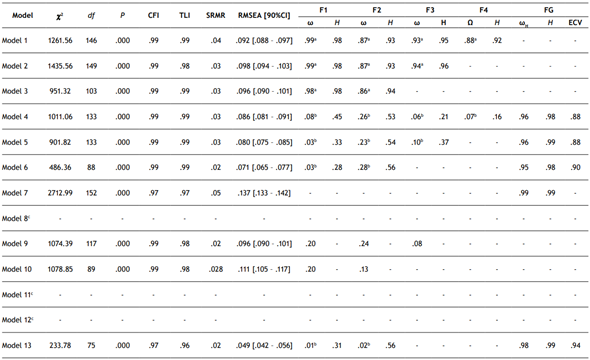
Note. Model 1 = Four factor related; Model 2 = Three factor related of Londoño et al. (2012); Model 3 = Two factor related of Martínez et al. (2014); Model 4 = Bi-factor model with four factors related; Model 5 = Bi-factor model of Londoño et al. (2012); Model 6 = Bi-factor model of Martínez et al. (2014); Model 7 = Unidimensional model; Model 8 = Four-factor ESEM model; Model 9 = Three-factor ESEM model; Model 10 = Two-factor ESEM model. a = McDonald’s Omega; b = Hierarchical Omega; H = H Coefficient; ωH = Hierarchical Omega; ECV = Explained Common Variance. c = The model could not be estimated, it presented estimation problems.
Regarding the bi-factor indices of model 6, it can be seen that the general factor presents a high ECV (.90), showing that the general factor explains 90% of the variance of the items. Regarding the specific ECVs, factor 1 (.04) and factor 2 (.32) manage to explain 4% and 32% of the common variance, respectively. Results showed that most of the items are strongly influenced by the general factor (I-ECV > .85), except for items 2 (.71), 5 (.73), 12 (.63), and 15 (.68). The PUC was equal to .40, which indicated that 40% of the correlations are contaminated by multidimensionality, while 60% of the correlations were explained by the general factor. The ARPB was equal to .03, which suggested that the factor loadings of the two-factor model and the factor loadings of a one-dimensional model only differed by 3%, being within the acceptable ranges. The H coefficient was equal to .98, which shows stability in other studies, while the Hs of the specific factors were less than .70, providing evidence favoring a general factor. Finally, the FD for the general factor (.99) and factors 1 (.85) and 2 (.90) showed that only the general factor score should be used for the analyses. These results underscored the relevance of a bi-factor model. Additionally, ESEM models were tested for the four, three, and two related factor models. As shown in Table 2, model 8 presented adjustment problems, and models 9 and 10 presented adjustment problems to the data as well. Bi-factor ESEM (B-ESEM) models were also evaluated for the three original models. Table 2 shows that models 11 and 12 presented estimation problems. Only model 13 presented adequate data fit indices (χ2 = 233.78; df = 75; p = .000; RMSEA = . 049 ( CI90% . 042 - . 056); S RMR = . 02; C FI=.97; T LI=.96).
It can be seen that model 6 and model 13 had a similar fit to the data. Following a parsimony criterion, that is, the simplest model is always the best model, it was decided to choose model 6. Therefore, model 6 was used for the following psychometric analyses.
In Figure 1, the factor loadings of the items with the general factor are significant and high. It can also be seen that the two specific factors present significant factor loadings with most of their items.
Factorial invariance according to sex
Table 3 shows that the factorial structure of the MOS-SSS questionnaire did not show evidence of metric invariance (Δχ2 = 43.68, p = .039; ΔCFI = .023; ΔRMSEA = -.021) for the group of men and women. Therefore, the other invariance models cannot be interpreted: scalar (Δχ2 = 32.20, p = .009; ΔCFI = -.006; Δ RMSEA = .004) a nd s trict (Δχ2 = 18.51, p = .294; ΔCFI = .000; ΔRMSEA = -.002). It is concluded that the questionnaire did not show evidence of being invariant for men and women.
Table 3 Adjustment indices of the invariance models according to sex

Nota: χ 2 = Chi square; df = degrees of freedom; SRMR: Standardized Root Mean Square Residual; TLI = Tucker-Lewis Index; CFI = Comparative Fit Index; RMSEA = Root Mean Square Error of Approximation; Δx 2 = Differences in Chi square; Δdf = Differences in degrees of freedom; ΔRMSEA = Change in Root Mean Square Error of Approximation; ΔCFI = Change in Comparative Fix Index.
Scale reliability
Table 2 shows that the two-factor bi-factor model with two specific factors (model 6) presented adequate levels of reliability. The hierarchical omega coefficient was adequate for the general factor (ωH = .95) and for the specific factors of emotional/informational support (ωhs = .03) and tangible support (ωhs = .28). Similarly, the general factor and its dimensions presented an adequate H coefficient (HHG = 98; Hhs = .28; Hhs = .56 respectively).
Validity based on the relationship with other constructs
Taking into account a review of the literature, an SEM model was proposed to assess the latent relationship between the perceived social support scale and the experienced fear of COVID-19. The explanatory model presented adequate fit indices (χ2 = 460.06; df = 211; p = .000; RMSEA = .036; CFI = .99; TLI = .99) and the measurement models were adequately represented by their items.
Perceived social support significantly predicted physiological (-.26; p < .01) and emotional (-.27; p < .01) symptoms of fear experienced because of COVID-19 (Figure 2). Taking these results into account, it can be concluded that the scale presented adequate validity based on its relationship with other constructs.
Regression models
Table 4 shows that perceived social support predicted only 4% variance of the physiological component of fear of COVID-19 (ΔR2 = .04; p < .01). In addition, the regression coefficient for the Social support × Gender interaction was not statistically significant (β3 = .01; p > .05). Perceived social support predicted only 4% variance of the emotional component of fear of COVID-19 (ΔR2 = .04; p < .01) as well. The regression coefficient for the Social support × Gender interaction was not statistically significant (β3 = .01; p > .05) either. Based on these results, it was concluded that the moderation analysis showed that the effects of perceived social support on the components of fear of COVID-19 were similar for the groups of men and women.
Discussion
This study investigated the psychometric properties of the MOS-SSS in a general sample from Mexico during the COVID-19 pandemic. Using Confirmatory Factor Analysis (CFA), the results showed that the hypothesized bi-factor model of Martínez et al. (2014) (16 items distributed in two specific factors and one general factor, items 1, 3, 4, 6 were removed) was appropriate due to the measurement level of the scale (Brown, 2015). The names of the factors “Emotional/Informational Support” and “Tangible Support” are similar to the names of Martínez et al.’s model solution. Because the questionnaire was applied at the beginning of the pandemic in Mexico, when the population was asked to stay at home, Emotional/Informational Support (referring to affectivity and empathy) and Tangible Support (providing material or behavioral assistance) gained strength not only in the country, but also in other contexts as contributing elements for physical, mental and emotional well-being in different population groups (Gupta & Sahoo, 2020; Lloyd-Jones, 2021). Therefore, the effect of these two resulting factors is understandable. This model omits three items, “Someone you can count on when you need to talk,” “Someone to give you advice when you have problems,” and “Someone to show you love and affection.” This shows that the relationship of these items with social support as a construct did not contribute to the specification of the model and, thus, their operability within the context is very low and perhaps even nonexistent (Ceballos et al., 2017; Domínguez-Lara, 2019).
Bi-factor models are considered to be suitable for multifaceted item factor structures that assess highly related domains and are assumed to comprise a general factor (Chen et al., 2006). This result revealed that the MOS-SSS measures a general factor of perceived social support and two specific factors that correspond to domains of perceived social support. In this sense, the items measuring “Emotional/Informational Support” and “Tangible Support” are manifestations of the general factor perceived social support. To our knowledge, the bi-factor model has not yet been evaluated in studies investigating the psychometric properties of the MOS-SSS. The bi-factor model allows for a comparison of the strength of a general MOS-SSS factor relative to specific factors, estimates the size of the factor loadings of each item, and provides additional information regarding the unidimensionality of the MOS-SSS. Similarly, the low factor loadings on the specific factors suggest that the calculation and use of a total MOS-SSS score are appropriate and would reflect a single latent construct (Reise, 2012).
The adequate fit of the bi-factor model of the MOS-SSS suggests important aspects for its clinical use. First, there is an underlying general perceived social support. Second, considering perceived social support as a single factor does not sufficiently explain its full significance for Mexican individuals. That is, Mexican individuals tend to experience social support due both generally and through its two dimensions (Emotional/Informational Support and Tangible Support). This means that mental health professionals conceptualizing social support in Mexican individuals should consider it not only in a general way, but also on the basis of its unique aspects related to Emotional/Informational support as well as tangible support. Consequently, each of these dimensions offers unique targets for intervention by the mental health professional. Regarding the internal consistency of the questionnaire, analyses yielded adequate scores for both the omega and H coefficient (Mueller & Hancock, 2001; Viladrich et al., 2017), indicating that it is reliable in the Mexican population.
On the other hand, perceived social support was negatively associated with the emotional and physiological dimensions of fear of COVID-19. This would indicate that an increase in perceived social support would be associated with a decrease in fear of COVID-19. The positive effects of perceived social support on mental health during the pandemic have been previously identified (Liu et al., 2020; Muyor-Rodríguez et al., 2021; Qi et al., 2020). The change in daily routines disrupted our social relationships and, in this context, the social support received became very limited, which gave greater importance to perceived social support. In this sense, it would be important to favor practices that strengthen people’s perception of social support and, thus, improve their ability to cope with the fear of COVID-19. Considering that perceived social support would be shaped by a strong perception of one’s own community, it is essential to plan social services related to the Mexican population.
This study has limitations that raise important lines of future research. First, it is difficult to generalize the results of this study to the entire general population of Mexico because the current sample was selected by non-probability purposive sampling. Second, the current study related the MOS-SSS to the fear of COVID-19; however, social support is related to different variables related to mental health during the pandemic, such as loneliness (Saltzman et al., 2020), emotional intelligence (Zysberg & Zisberg, 2022), among others. In this regard, future research could examine the relationship of the MOS-SSS with a wider variety of variables, not only with the goal of providing further evidence of convergent or divergent validity, but also to determine the beneficial effects of social support as measured by the MOS-SSS. Third, a selection bias is present because participants had to have internet access in order to answer the online survey, which could affect the generalizability and representativeness of the results.
Despite the limitations, the MOS-SSS can be used in practice as an initial or follow-up evaluation measure to determine the effectiveness of interventions aimed at strengthening perceived social support and its specific dimensions, reflected in its specific factors. In this sense, the rapid administration and ease of understanding of its items can help inform psychoeducational interventions. In conclusion, the 16-item MOS-SSS presented psychometric evidence suitable for use in measuring perceived social support during the COVID-19 pandemic and for determining the effectiveness of health promotion interventions1.














